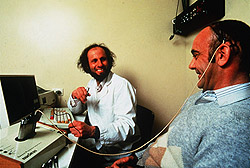|
After
the operation
After the operation to implant the internal parts of
the system the external parts have to be fitted. Once
the implant system is turned on, the brain is able to
interpret sound. However, if the person has been deaf
for a long time, or is a child who has not learnt to
speak, they may find it difficult to understand the
sounds that their brain is receiving. The recipient
will need an audiologist to assist them in recognising
sounds around them.
The
cochlear implant enables the recipient to recognise
and understand speech and many are able to use the telephone.
Some people have to use lip reading to assist in their
understanding. The implant has been used by children
as young as 14 months to adults 80 years old. Each recipient
has a different level of success. The implant is most
successful for adults who have developed a hearing loss.
Studies show that they are able to recognise 80% of
speech without lip reading. It is much more difficult
for people who have been deaf since birth. They have
to learn the association of words and sounds, which
can be difficult when they have never heard them before.
|
The
role of the audiologist
An audiologist must spend many hours with each
implant recipient, assessing the patient before
the operation, customising the speech processor
afterwards and training the recipient in its use.
|

Rod Saunders, the first person
to receive a Cochlear implant, with his audiologist.
(Cochlear Pty Ltd) |
|
One
of the innovative features of the Cochlear implant system
is the distribution.
Paul
Trainor, leader of the team at Cochlear that designed
and manufactured the Mini System 22 decided that the
implant should be distributed and sold through special
clinics. Audiologists, surgeons, engineers, psychologists,
experienced implant users and teachers are available
at these clinics to provide the high standards of
service and care needed to help the new implant user.
(Renew, 1993: 99)
Responses
to receiving an implant
Just as the effect for each person is unique, so too,
are their responses to having the implant.
|
Sue
Walters has a cochlear implant.
…once
you've been a hearing person, you'd really love
to have your hearing back …and the implant
is about the closest that we've come so far.
People who have residual hearing can use hearing
aids and hear quite well with them. But for
someone who's profoundly deaf like myself, there's
no other alternative. So I'd much prefer to
have the implant... than nothing at all. (Powerhouse
Museum)
view video (windows
media player reqired)
|
|
For
further responses from implantees:
Rob Kilgore, an American, received his cochlear implant
in the early 1980s. Here is the story he told in 1993
to a gathering in honour of Australian scientist Professor
Graeme Clark. http://www.science.org.au/nova/029/029box04.htm
The
Cochlear Nucleus family
http://www.cochlear.com/rcs/cochlear/publisher/web/candidates/candidates_home/
Click here for comments from
parents of children with a cochlear implant.
|